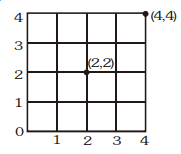- Tardigrade
- Question
- Mathematics
- Column I Column II A 24 C 2+ 23 C 2+ 22 C 2+ 21 C 2+ 20 C 2+ 20 C 3 is equal to p 102 B In the adjoining figure number of progressive ways to reach from (0,0) to (4,4) passing through point (2,2) are (particle can move on horizontal or vertical line) <img class=img-fluid question-image alt=image src=https://cdn.tardigrade.in/img/question/mathematics/c25899c24c5f7f2245ea00cf662f72c2-.png /> q 2300 C The number of 4 digit numbers that can be made with the digits 1,2,3,4,3,2 r 82 D If (500 !/14 k ) =0, then the maximum natural value of k is equal to (where . is fractional part function) s 36
Q.
Column I
Column II
A
is equal to
p
102
B
In the adjoining figure number of progressive ways to reach from to passing through point are (particle can move on horizontal or vertical line)

q
2300
C
The number of 4 digit numbers that can be made with the digits
r
82
D
If , then the maximum natural value of is equal to (where . is fractional part function)
s
36
| Column I | Column II | ||
|---|---|---|---|
| A | is equal to | p | 102 |
| B | In the adjoining figure number of progressive ways to reach from to passing through point are (particle can move on horizontal or vertical line)  |
q | 2300 |
| C | The number of 4 digit numbers that can be made with the digits | r | 82 |
| D | If , then the maximum natural value of is equal to (where . is fractional part function) | s | 36 |
Solution: